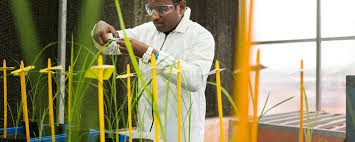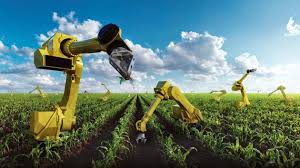The great boom of technology is having great impact on all industries and agriculture is no exception. This is the perfect opportunity to find solutions for new issues: the demand for a greater productivity, high quality products and the challenges of climate change. The UK Food and Agriculture Association estimates that the world population will increase 47%, to 8.9 billion by 2050.
The production in agriculture must double in the next 30 years to be able to sustain the population growth and at the same time the amount of arable lands is decreasing.
Luckily there are a huge amount of organisations looking at how we can better use tech to focus on smarter and more efficient growing techniques!
These are the top tech that we think could make a big impact:
1. IT in agriculture
We start with the integration of big data in agriculture. Big data is already embedded in agriculture but we are seeing the need for apps to support in the decision making process.
Today, lots of applications are emerging to help farmers being more efficient by providing personalized information on watering, use of chemicals, seed placement, weather or even soil type. Apps like CropX and Hortau work to optimize the production, controlling water utilization and yield for example.
There are a huge amount of organizations looking at how we can better use tech to focus on smarter and more efficient growing techniques!
We see these better softwares as a great leverage for productivity now and onwards. Right now, in Cambodia, where we work, the majority of smallholder farmers don’t have a smartphone. As such, our human interactions and support via field agents is crucial, even if we are implementing more and more apps trial in our system. Hence, our take on this for the moment is apps and IT for agents, not yet for farmers.
Blockchain is starting to be big too. It’s the engine that drives the more well known ‘bitcoin’. It is a decentralised, transparent way to keep a log of transactions. People can securely exchange money without the risk of fraud or theft. There’s a huge amount of buzz about how it can be used in developing countries to help people out of poverty.
The Bill and Melinda Gates Foundation are aiming to use blockchain to help two billion people in the world who don’t have bank accounts through their Level One Project. The World Food Programme is having a few trials blockchain in Pakistan to make their cash transfers, quicker and more secure.
We think this is a very promising solution for rural areas of developing countries that have very low level of banking infrastructure. Similar to the apps, this is going to depend on smartphone penetration which varies country by country. For our farmers, there’s not yet a case.
2. Low cost aquaponics
Aquaponics is anew way of doing agriculture. Vegetables are grown in a nutrient rich water rather than in the soil. The naturally produced waste from fish and vegetables work in a circular balance. They thrive off each other. No water goes to waste.
This means that pollution is drastically reduced as soil is not eroding and there is no need for harsh insecticides. It is a mutually-balanced ecosystem that provides great yields of fast-growing organic produce. These years, we are seeing more and more initiatives, in Nepal, India and Bangladesh mostly, that bring the tech to smallholder by making it low cost.
At Project Alba we see this as a great use of water in water-scarce areas. The issue is that the investment per farmer is still high, typically above USD 2,000. Yet, we will be looking at the evolution of our work and by 2019 begin to test options with our research team and our more advanced farmers.
Read Also: The 10 Best Business Ideas on Agriculture
3. Biotech in seeds and biocontrols

A lot of research is being undertaken in plant genomics, plant pests and agronomy. In turn, this is increasing the offer of up biotechnology applications and alternatives.
Two key techs are always getting better and some advance are still going to be big 2018. In heat resistant seeds, a few rice varieties are spreading fast and heat-resistant seeds for tomatoes and cucumbers are getting better and more readily available from commercial growers.
The second tech, bio controls is improving at an even greater rate. With more and more legislations on chemicals (neonicotinoids being banned from a few european countries last year), the research is focusing on biological organisms to tackle weeds and insects.
New strains of the famous Bacillus Thurigiensis, a bacteria well known for its natural insecticides power, for beetle and caterpillar control, are being developed. Same for Trichoderma, a symbiosis for vegetables that has some protective properties.
We love this and all in on these techs. An issue at times is the legislation and local availability. Cambodia actually has made great legal progress last year in that sense. Bio-control are already 60% of our pest control budgets and use, and if the sector progresses fast, we could make it 100% within the next 2-3 year!
4. Small mechanization – big changes
Small mechanisation must not be forgotten here. It’s sometimes surprising, but labour is often a constraint in developing countries and reducing labour needs for smallholder farmers has a major effect on their income as they can manage more land.
The availability of adapted technology to smallholder farmers is every year bigger. Drip irrigation was adapted a few years back, small pumps make a huge difference and in Cambodia, we foresee bed makers, weeders can become widespread within 2018 and 2019, as labour needs tend to be concentrated into weeding and land preparation.
That’s also some possible big wins for our farmers. We will be testing sharing mechanisms this year so that these tools could be used by more than one farmers.
Read Also: Top 50 Agriculture Business Ideas for Aspiring Entrepreneurs
5. Packaging innovation
Breakthroughs in packaging design are incredibly impressive right now. Today package companies are able to provide packages which are increasingly protective for our food. Many Packages now are capable of prolonging the shelf life of the product.
Packaging innovations can be a great help in terms of cost efficiency and reduce of waste products. Innovations such as corn starch pressed bags are kind to the environment. Many biodegradable products have been introduced and many more innovations are to come and many will be more game changing that we thought!
At Project Alba we’re exploring options for packaging, particularly as we explore the export market and the opportunities that lie ahead for Cambodian produce. We are happy packaging is improving so much as we seriously need to reduce plastic.
Final thoughts…
A lot of technology for very advanced farms is really impressive in the hardware and in what it does. A the same time, and given that smallholder farmers will be the key component to produce 75% more food within 30 years, the sometimes less fancy tech that’s made available for smallholder, because it’s adapted, less costly or both, is what we believe will matter most for global food production.
Read Also: Products That Can Be Derived From Marine Debris

